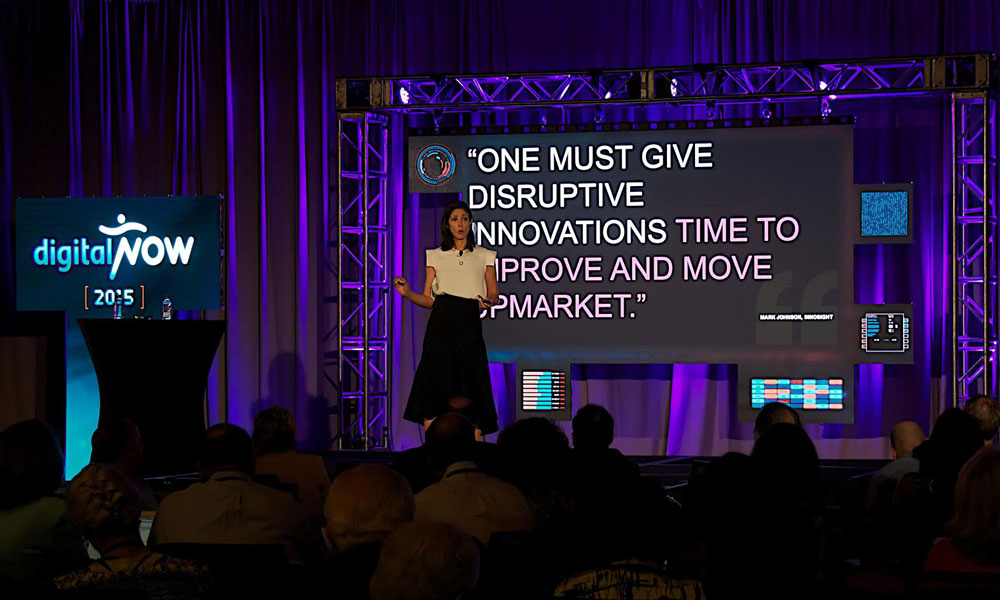
The Collaborative Economy: Disruption and Opportunity for Associations
Uber, Airbnb, and other companies in the sharing economy are borrowing some of associations' key sources of value—collaboration and networks—and disrupting industries left and right, according to author Rachel Botsman.
When Rachel Botsman’s book on the sharing economy, What’s Mine Is Yours, was published in 2009, it was, in her words, a total flop. It turned out she was just ahead of her time. Four years later, The Economist turned to her as a leading expert when it marked the rise of the sharing economy on its March 9, 2013, cover.
Those few short years define how fast the sharing, or collaborative, economy has grown exponentially, and today companies like Uber, Airbnb, and TaskRabbit are disrupting entire industries. And they’re doing it with a fundamental zeal for collaboration, long the bread and butter of associations. As Botsman told attendees during her keynote presentation Thursday at the 2015 Digital Now conference, companies in the collaborative economy have borrowed much from associations’ playbook, with business models built on trust, neutral matchmaking, and bringing people together—and now these startups are doing it better than associations.
Companies in the collaborative economy have borrowed much from associations’ playbook, with business models built on trust, neutral matchmaking, and bringing people together.
The biggest difference between associations and collaborative-economy companies is “the way they think about relationships with their members or users or customers or whatever you choose to call them,” Botsman said. “What associations would think of as a two-way relationship and engagement would be laughed at in many of these organizations, where community is part of their DNA from day one. It’s not something that’s added on; it’s not something you have to manage. It’s integral to the way they create value.”
The rise of the collaborative economy has followed closely on the rise of social media and smartphones, technologies that allow people to better connect with each other to unlock hidden value in underutilized assets, Botsman said. She cited the example of French ride-sharing network Bla Bla Car, whose founders noticed how many cars on the road have one driver and multiple empty seats. Those seats had underutilized value that could be realized if only people were easily connected to share them.
Simply connecting people in trusting communities is at the core of what collaborative-economy companies do. Most of them don’t create and sell products; instead, they facilitate the connections for people to do the creating and selling on their own. Botsman said industries with any of five particular qualities are ripe for this style of disruption: complex experiences, waste, broken trust, redundant middlemen, and limited access.
Those being disrupted by the collaborative economy can ignore it or fight it, or they can embrace it instead. For associations, Botsman said, the key is to have faith in the value of community.
“There’s such fear around the freemium model, and I get it. Sometimes you think, ‘God, I give so much away,’ but it does come back, but it’s not in the way you expect,” she said. “We’re so used to a linear way of thinking about value: People pay here, we’ll offer value, and they’ll return value. You can’t think of it like that. You’ve got to think of networked value.”
What exactly does that mean? “People have such a strong association and loyalty to being part of the group that they are with you in a long-term relationship and they’ll think of paying for things in a very different ways than asking them upfront for a set fee, where they haven’t established a relationship with the organization.”
The rise of the collaborative economy may also be creating new opportunities for associations. As the definition of work changes and the collaborative economy allows more people to work independently, it raises uncertainties about how independent workers find the security, stability, learning opportunities, and community they may have previously found in the traditional workplace.
“People definitely value independence and flexibility, but there’s still a need to belong to something that’s bigger than their individual selves. There’s still a need to be a part of a network of people. There’s a need to have someone to turn to when things go wrong,” she said. “There’s a real opportunity for associations to play that convening role to make people who work independently not feel so alone and feel part of a network.”
In the United States, the Freelancers Union is one organization that is starting to play such a role, Botsman said. “If you think about traditional career paths, you have learning programs along the way. If you suddenly go independent, how do you identify what you need, get what you need, have mentors, have networks of support? So, how associations can reinvent learning for this independent contractor world could be really interesting as well.”
(Fusion Productions)






Comments